Health & Safety: Mitigating Minor Accidents on Construction Sites
VerifiedAdded on 2020/06/04
|16
|5877
|36
Report
AI Summary
This report delves into the critical topic of health and safety within the construction industry, specifically focusing on the mitigation of minor and near-miss accidents. It begins with an overview of the hazardous nature of construction work, highlighting the various risks associated with it, such as falls, electrocutions, and exposure to hazardous materials. The report then explores the rationale, aim, objectives, and research questions guiding the study, which centers on a case study of a leading UK-based construction service provider. The literature review examines different types of accidents, the importance of site inductions, and the impact of these inductions on reducing accident rates. The methodology section outlines the research philosophy, design, approach, data collection methods, and ethical considerations. The report aims to identify various types of minor accidents, determine the role and impact of site inductions, and recommend strategies for minimizing accidents. The study underscores the importance of proactive measures, such as comprehensive site inductions and proper risk assessment, to create a safer and more productive work environment. The report emphasizes the need for management to prioritize health and safety to protect workers and comply with regulations. The findings and recommendations are based on the analysis of the case study and the existing literature, offering valuable insights for construction companies to improve their safety protocols.
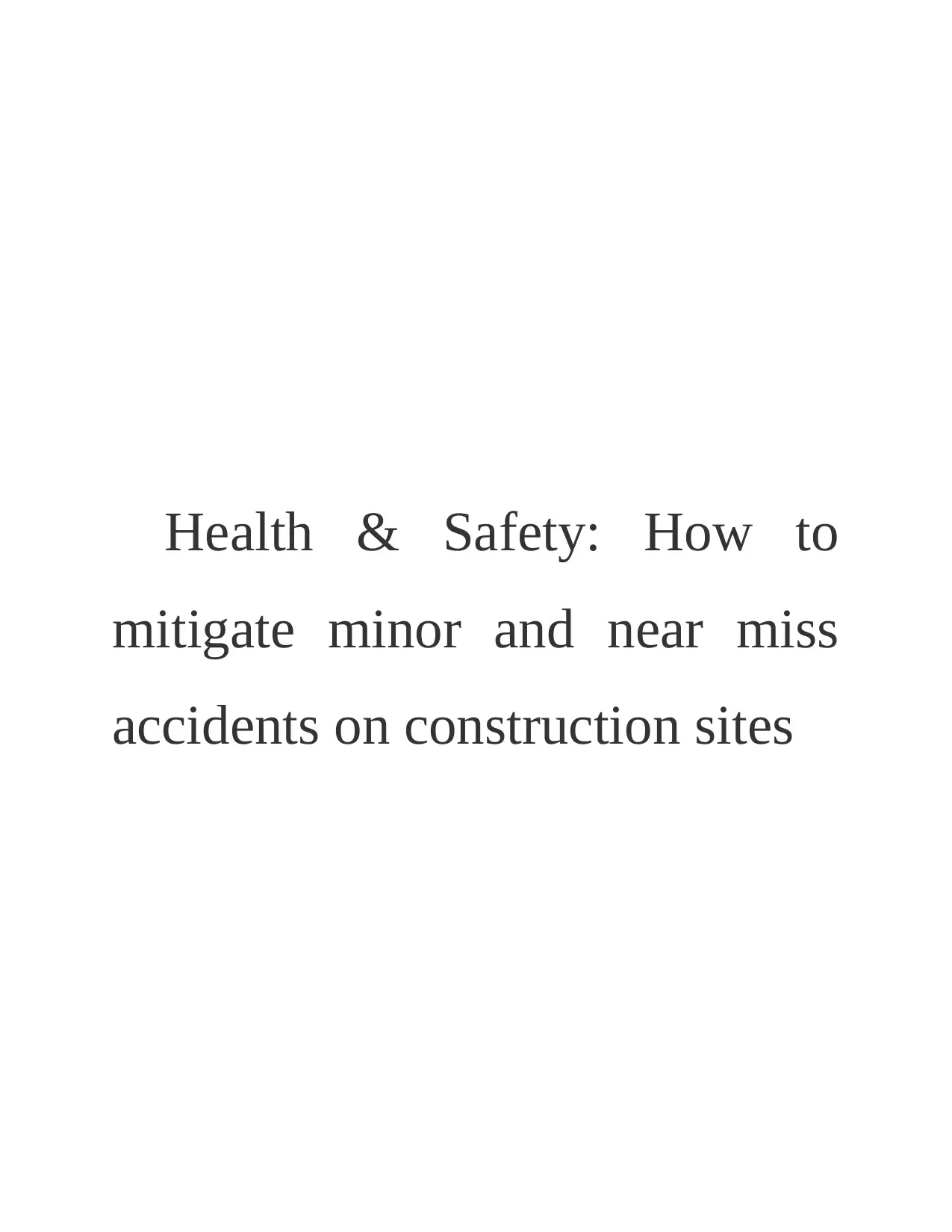
Health & Safety: How to
mitigate minor and near miss
accidents on construction sites
mitigate minor and near miss
accidents on construction sites
Paraphrase This Document
Need a fresh take? Get an instant paraphrase of this document with our AI Paraphraser
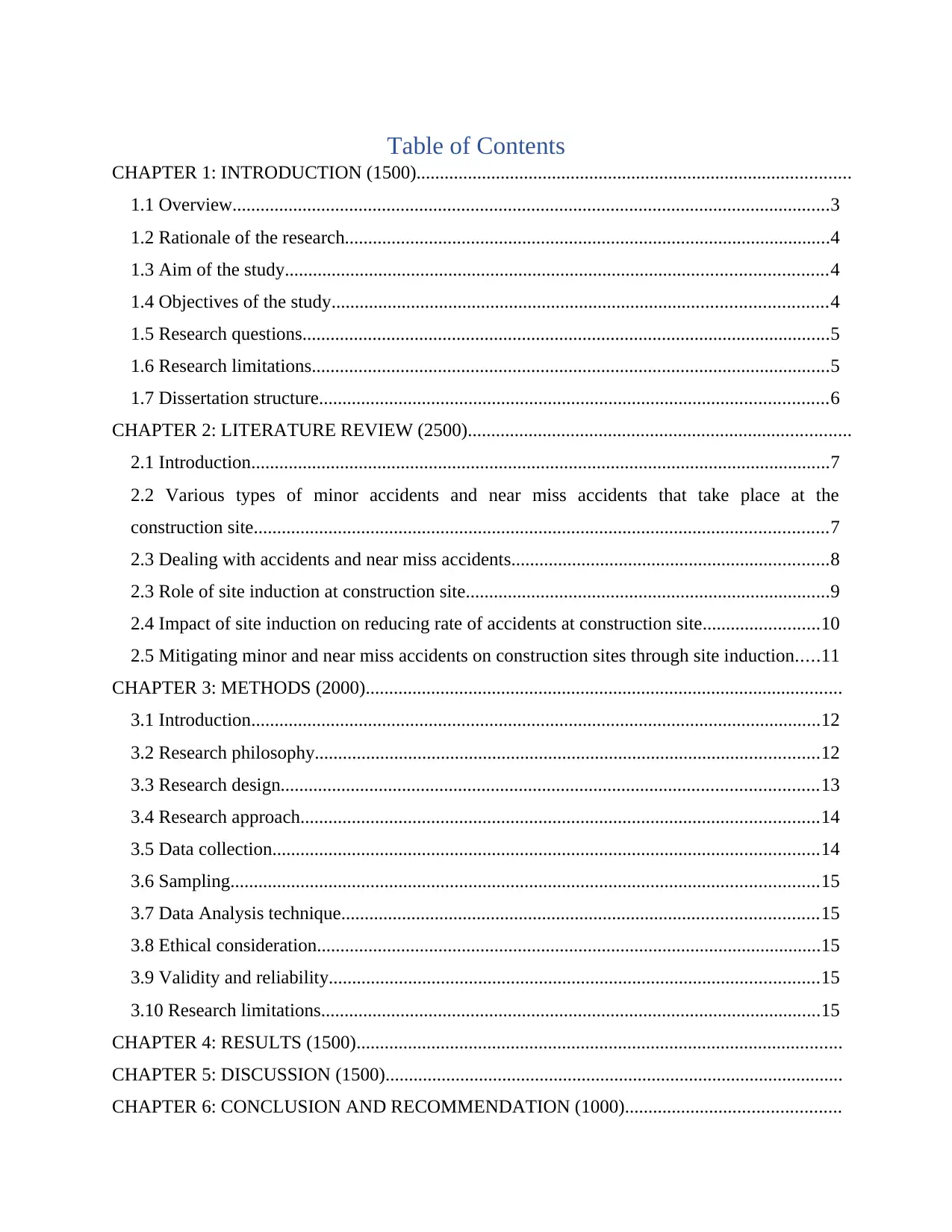
Table of Contents
CHAPTER 1: INTRODUCTION (1500).............................................................................................
1.1 Overview................................................................................................................................3
1.2 Rationale of the research........................................................................................................4
1.3 Aim of the study....................................................................................................................4
1.4 Objectives of the study..........................................................................................................4
1.5 Research questions.................................................................................................................5
1.6 Research limitations...............................................................................................................5
1.7 Dissertation structure.............................................................................................................6
CHAPTER 2: LITERATURE REVIEW (2500)..................................................................................
2.1 Introduction............................................................................................................................7
2.2 Various types of minor accidents and near miss accidents that take place at the
construction site...........................................................................................................................7
2.3 Dealing with accidents and near miss accidents....................................................................8
2.3 Role of site induction at construction site..............................................................................9
2.4 Impact of site induction on reducing rate of accidents at construction site.........................10
2.5 Mitigating minor and near miss accidents on construction sites through site induction.....11
CHAPTER 3: METHODS (2000)......................................................................................................
3.1 Introduction..........................................................................................................................12
3.2 Research philosophy............................................................................................................12
3.3 Research design...................................................................................................................13
3.4 Research approach...............................................................................................................14
3.5 Data collection.....................................................................................................................14
3.6 Sampling..............................................................................................................................15
3.7 Data Analysis technique......................................................................................................15
3.8 Ethical consideration............................................................................................................15
3.9 Validity and reliability.........................................................................................................15
3.10 Research limitations...........................................................................................................15
CHAPTER 4: RESULTS (1500)........................................................................................................
CHAPTER 5: DISCUSSION (1500)..................................................................................................
CHAPTER 6: CONCLUSION AND RECOMMENDATION (1000)..............................................
CHAPTER 1: INTRODUCTION (1500).............................................................................................
1.1 Overview................................................................................................................................3
1.2 Rationale of the research........................................................................................................4
1.3 Aim of the study....................................................................................................................4
1.4 Objectives of the study..........................................................................................................4
1.5 Research questions.................................................................................................................5
1.6 Research limitations...............................................................................................................5
1.7 Dissertation structure.............................................................................................................6
CHAPTER 2: LITERATURE REVIEW (2500)..................................................................................
2.1 Introduction............................................................................................................................7
2.2 Various types of minor accidents and near miss accidents that take place at the
construction site...........................................................................................................................7
2.3 Dealing with accidents and near miss accidents....................................................................8
2.3 Role of site induction at construction site..............................................................................9
2.4 Impact of site induction on reducing rate of accidents at construction site.........................10
2.5 Mitigating minor and near miss accidents on construction sites through site induction.....11
CHAPTER 3: METHODS (2000)......................................................................................................
3.1 Introduction..........................................................................................................................12
3.2 Research philosophy............................................................................................................12
3.3 Research design...................................................................................................................13
3.4 Research approach...............................................................................................................14
3.5 Data collection.....................................................................................................................14
3.6 Sampling..............................................................................................................................15
3.7 Data Analysis technique......................................................................................................15
3.8 Ethical consideration............................................................................................................15
3.9 Validity and reliability.........................................................................................................15
3.10 Research limitations...........................................................................................................15
CHAPTER 4: RESULTS (1500)........................................................................................................
CHAPTER 5: DISCUSSION (1500)..................................................................................................
CHAPTER 6: CONCLUSION AND RECOMMENDATION (1000)..............................................

REFERENCES...................................................................................................................................
⊘ This is a preview!⊘
Do you want full access?
Subscribe today to unlock all pages.

Trusted by 1+ million students worldwide
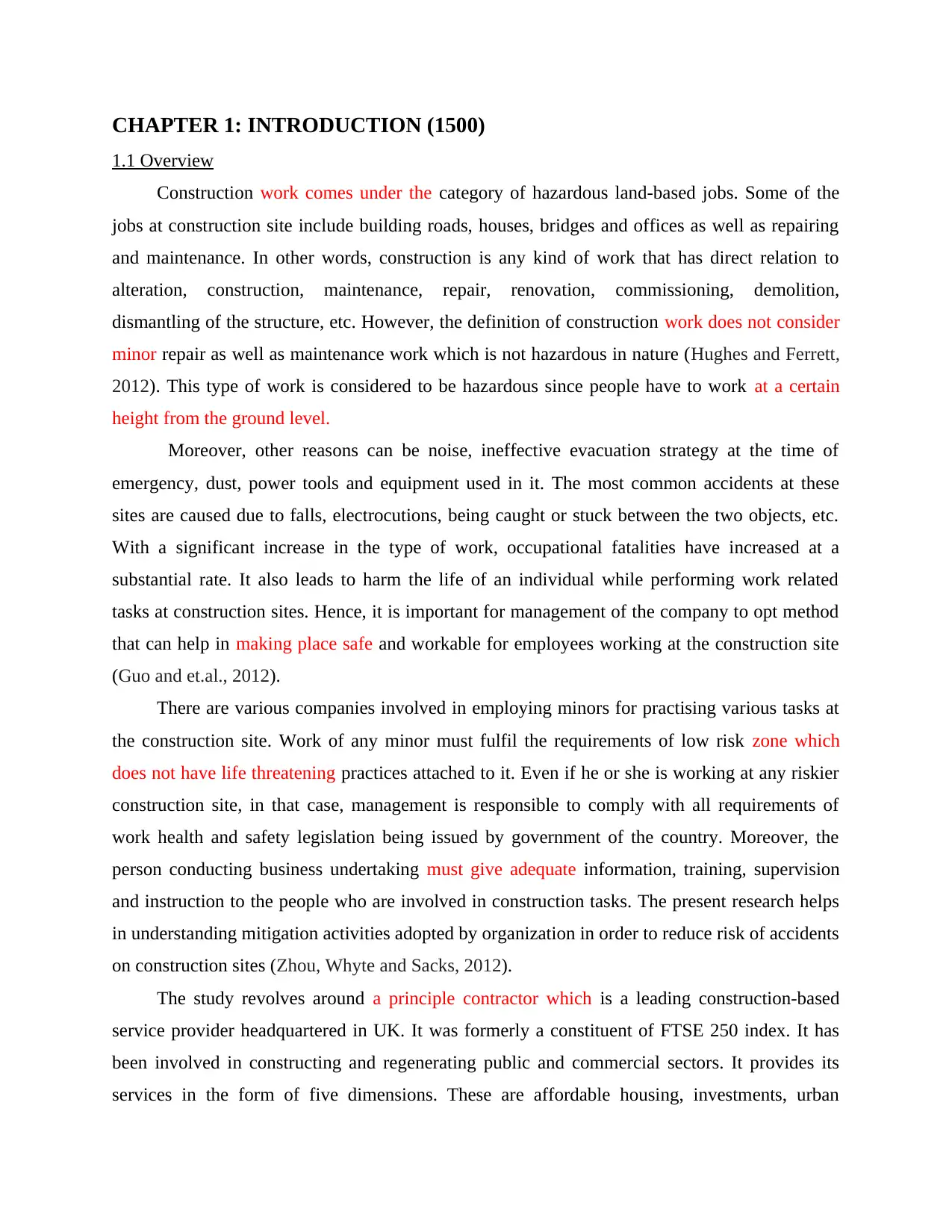
CHAPTER 1: INTRODUCTION (1500)
1.1 Overview
Construction work comes under the category of hazardous land-based jobs. Some of the
jobs at construction site include building roads, houses, bridges and offices as well as repairing
and maintenance. In other words, construction is any kind of work that has direct relation to
alteration, construction, maintenance, repair, renovation, commissioning, demolition,
dismantling of the structure, etc. However, the definition of construction work does not consider
minor repair as well as maintenance work which is not hazardous in nature (Hughes and Ferrett,
2012). This type of work is considered to be hazardous since people have to work at a certain
height from the ground level.
Moreover, other reasons can be noise, ineffective evacuation strategy at the time of
emergency, dust, power tools and equipment used in it. The most common accidents at these
sites are caused due to falls, electrocutions, being caught or stuck between the two objects, etc.
With a significant increase in the type of work, occupational fatalities have increased at a
substantial rate. It also leads to harm the life of an individual while performing work related
tasks at construction sites. Hence, it is important for management of the company to opt method
that can help in making place safe and workable for employees working at the construction site
(Guo and et.al., 2012).
There are various companies involved in employing minors for practising various tasks at
the construction site. Work of any minor must fulfil the requirements of low risk zone which
does not have life threatening practices attached to it. Even if he or she is working at any riskier
construction site, in that case, management is responsible to comply with all requirements of
work health and safety legislation being issued by government of the country. Moreover, the
person conducting business undertaking must give adequate information, training, supervision
and instruction to the people who are involved in construction tasks. The present research helps
in understanding mitigation activities adopted by organization in order to reduce risk of accidents
on construction sites (Zhou, Whyte and Sacks, 2012).
The study revolves around a principle contractor which is a leading construction-based
service provider headquartered in UK. It was formerly a constituent of FTSE 250 index. It has
been involved in constructing and regenerating public and commercial sectors. It provides its
services in the form of five dimensions. These are affordable housing, investments, urban
1.1 Overview
Construction work comes under the category of hazardous land-based jobs. Some of the
jobs at construction site include building roads, houses, bridges and offices as well as repairing
and maintenance. In other words, construction is any kind of work that has direct relation to
alteration, construction, maintenance, repair, renovation, commissioning, demolition,
dismantling of the structure, etc. However, the definition of construction work does not consider
minor repair as well as maintenance work which is not hazardous in nature (Hughes and Ferrett,
2012). This type of work is considered to be hazardous since people have to work at a certain
height from the ground level.
Moreover, other reasons can be noise, ineffective evacuation strategy at the time of
emergency, dust, power tools and equipment used in it. The most common accidents at these
sites are caused due to falls, electrocutions, being caught or stuck between the two objects, etc.
With a significant increase in the type of work, occupational fatalities have increased at a
substantial rate. It also leads to harm the life of an individual while performing work related
tasks at construction sites. Hence, it is important for management of the company to opt method
that can help in making place safe and workable for employees working at the construction site
(Guo and et.al., 2012).
There are various companies involved in employing minors for practising various tasks at
the construction site. Work of any minor must fulfil the requirements of low risk zone which
does not have life threatening practices attached to it. Even if he or she is working at any riskier
construction site, in that case, management is responsible to comply with all requirements of
work health and safety legislation being issued by government of the country. Moreover, the
person conducting business undertaking must give adequate information, training, supervision
and instruction to the people who are involved in construction tasks. The present research helps
in understanding mitigation activities adopted by organization in order to reduce risk of accidents
on construction sites (Zhou, Whyte and Sacks, 2012).
The study revolves around a principle contractor which is a leading construction-based
service provider headquartered in UK. It was formerly a constituent of FTSE 250 index. It has
been involved in constructing and regenerating public and commercial sectors. It provides its
services in the form of five dimensions. These are affordable housing, investments, urban
Paraphrase This Document
Need a fresh take? Get an instant paraphrase of this document with our AI Paraphraser
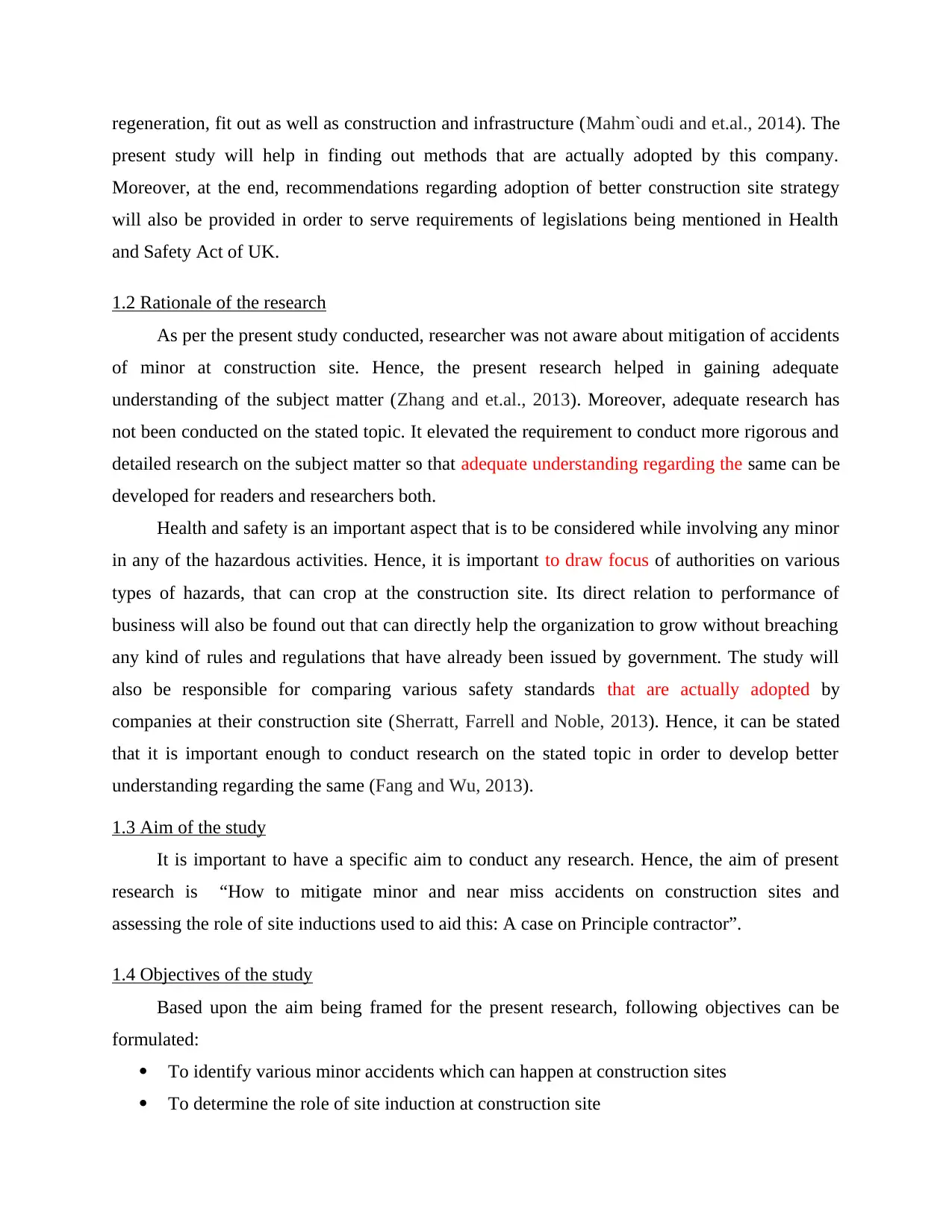
regeneration, fit out as well as construction and infrastructure (Mahm`oudi and et.al., 2014). The
present study will help in finding out methods that are actually adopted by this company.
Moreover, at the end, recommendations regarding adoption of better construction site strategy
will also be provided in order to serve requirements of legislations being mentioned in Health
and Safety Act of UK.
1.2 Rationale of the research
As per the present study conducted, researcher was not aware about mitigation of accidents
of minor at construction site. Hence, the present research helped in gaining adequate
understanding of the subject matter (Zhang and et.al., 2013). Moreover, adequate research has
not been conducted on the stated topic. It elevated the requirement to conduct more rigorous and
detailed research on the subject matter so that adequate understanding regarding the same can be
developed for readers and researchers both.
Health and safety is an important aspect that is to be considered while involving any minor
in any of the hazardous activities. Hence, it is important to draw focus of authorities on various
types of hazards, that can crop at the construction site. Its direct relation to performance of
business will also be found out that can directly help the organization to grow without breaching
any kind of rules and regulations that have already been issued by government. The study will
also be responsible for comparing various safety standards that are actually adopted by
companies at their construction site (Sherratt, Farrell and Noble, 2013). Hence, it can be stated
that it is important enough to conduct research on the stated topic in order to develop better
understanding regarding the same (Fang and Wu, 2013).
1.3 Aim of the study
It is important to have a specific aim to conduct any research. Hence, the aim of present
research is “How to mitigate minor and near miss accidents on construction sites and
assessing the role of site inductions used to aid this: A case on Principle contractor”.
1.4 Objectives of the study
Based upon the aim being framed for the present research, following objectives can be
formulated:
To identify various minor accidents which can happen at construction sites
To determine the role of site induction at construction site
present study will help in finding out methods that are actually adopted by this company.
Moreover, at the end, recommendations regarding adoption of better construction site strategy
will also be provided in order to serve requirements of legislations being mentioned in Health
and Safety Act of UK.
1.2 Rationale of the research
As per the present study conducted, researcher was not aware about mitigation of accidents
of minor at construction site. Hence, the present research helped in gaining adequate
understanding of the subject matter (Zhang and et.al., 2013). Moreover, adequate research has
not been conducted on the stated topic. It elevated the requirement to conduct more rigorous and
detailed research on the subject matter so that adequate understanding regarding the same can be
developed for readers and researchers both.
Health and safety is an important aspect that is to be considered while involving any minor
in any of the hazardous activities. Hence, it is important to draw focus of authorities on various
types of hazards, that can crop at the construction site. Its direct relation to performance of
business will also be found out that can directly help the organization to grow without breaching
any kind of rules and regulations that have already been issued by government. The study will
also be responsible for comparing various safety standards that are actually adopted by
companies at their construction site (Sherratt, Farrell and Noble, 2013). Hence, it can be stated
that it is important enough to conduct research on the stated topic in order to develop better
understanding regarding the same (Fang and Wu, 2013).
1.3 Aim of the study
It is important to have a specific aim to conduct any research. Hence, the aim of present
research is “How to mitigate minor and near miss accidents on construction sites and
assessing the role of site inductions used to aid this: A case on Principle contractor”.
1.4 Objectives of the study
Based upon the aim being framed for the present research, following objectives can be
formulated:
To identify various minor accidents which can happen at construction sites
To determine the role of site induction at construction site
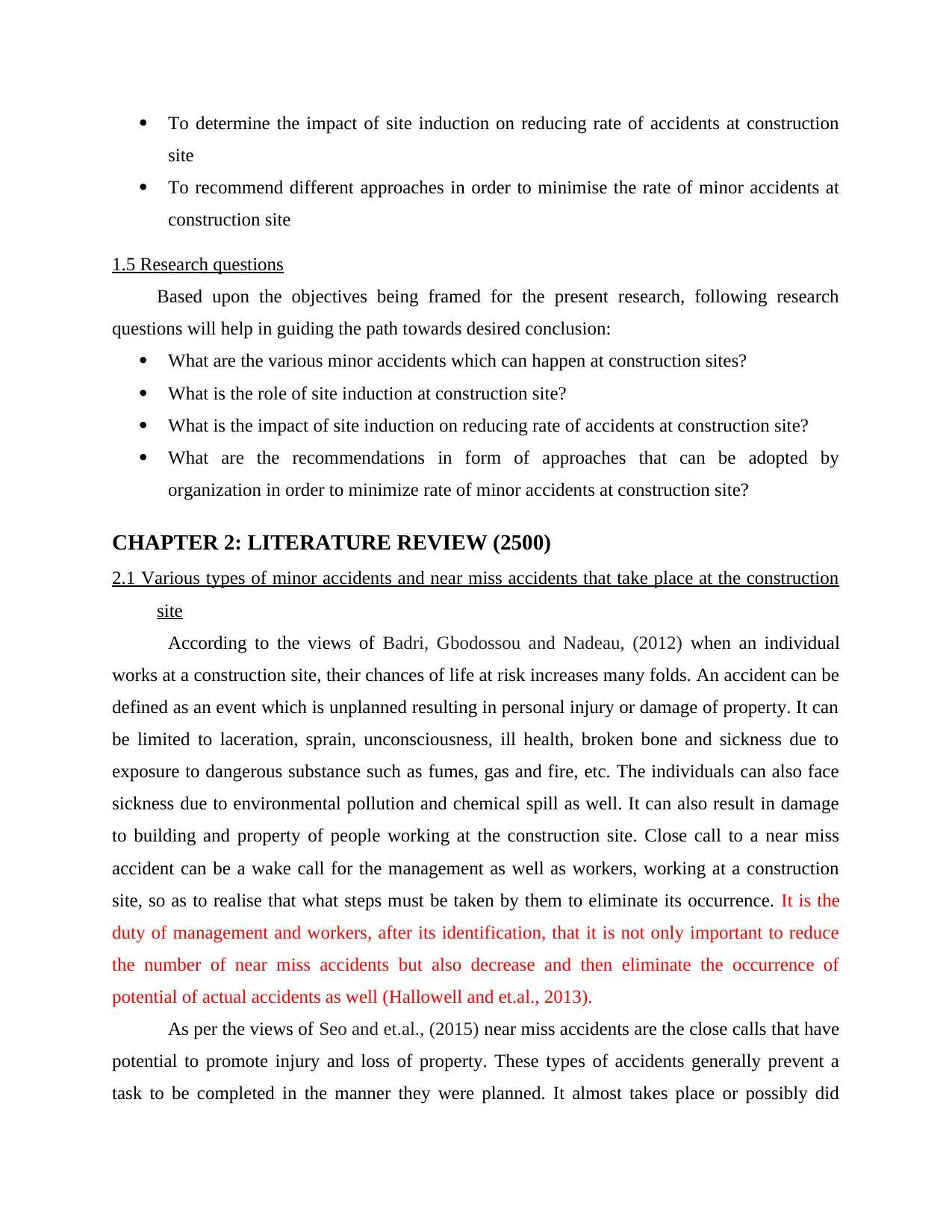
To determine the impact of site induction on reducing rate of accidents at construction
site
To recommend different approaches in order to minimise the rate of minor accidents at
construction site
1.5 Research questions
Based upon the objectives being framed for the present research, following research
questions will help in guiding the path towards desired conclusion:
What are the various minor accidents which can happen at construction sites?
What is the role of site induction at construction site?
What is the impact of site induction on reducing rate of accidents at construction site?
What are the recommendations in form of approaches that can be adopted by
organization in order to minimize rate of minor accidents at construction site?
CHAPTER 2: LITERATURE REVIEW (2500)
2.1 Various types of minor accidents and near miss accidents that take place at the construction
site
According to the views of Badri, Gbodossou and Nadeau, (2012) when an individual
works at a construction site, their chances of life at risk increases many folds. An accident can be
defined as an event which is unplanned resulting in personal injury or damage of property. It can
be limited to laceration, sprain, unconsciousness, ill health, broken bone and sickness due to
exposure to dangerous substance such as fumes, gas and fire, etc. The individuals can also face
sickness due to environmental pollution and chemical spill as well. It can also result in damage
to building and property of people working at the construction site. Close call to a near miss
accident can be a wake call for the management as well as workers, working at a construction
site, so as to realise that what steps must be taken by them to eliminate its occurrence. It is the
duty of management and workers, after its identification, that it is not only important to reduce
the number of near miss accidents but also decrease and then eliminate the occurrence of
potential of actual accidents as well (Hallowell and et.al., 2013).
As per the views of Seo and et.al., (2015) near miss accidents are the close calls that have
potential to promote injury and loss of property. These types of accidents generally prevent a
task to be completed in the manner they were planned. It almost takes place or possibly did
site
To recommend different approaches in order to minimise the rate of minor accidents at
construction site
1.5 Research questions
Based upon the objectives being framed for the present research, following research
questions will help in guiding the path towards desired conclusion:
What are the various minor accidents which can happen at construction sites?
What is the role of site induction at construction site?
What is the impact of site induction on reducing rate of accidents at construction site?
What are the recommendations in form of approaches that can be adopted by
organization in order to minimize rate of minor accidents at construction site?
CHAPTER 2: LITERATURE REVIEW (2500)
2.1 Various types of minor accidents and near miss accidents that take place at the construction
site
According to the views of Badri, Gbodossou and Nadeau, (2012) when an individual
works at a construction site, their chances of life at risk increases many folds. An accident can be
defined as an event which is unplanned resulting in personal injury or damage of property. It can
be limited to laceration, sprain, unconsciousness, ill health, broken bone and sickness due to
exposure to dangerous substance such as fumes, gas and fire, etc. The individuals can also face
sickness due to environmental pollution and chemical spill as well. It can also result in damage
to building and property of people working at the construction site. Close call to a near miss
accident can be a wake call for the management as well as workers, working at a construction
site, so as to realise that what steps must be taken by them to eliminate its occurrence. It is the
duty of management and workers, after its identification, that it is not only important to reduce
the number of near miss accidents but also decrease and then eliminate the occurrence of
potential of actual accidents as well (Hallowell and et.al., 2013).
As per the views of Seo and et.al., (2015) near miss accidents are the close calls that have
potential to promote injury and loss of property. These types of accidents generally prevent a
task to be completed in the manner they were planned. It almost takes place or possibly did
⊘ This is a preview!⊘
Do you want full access?
Subscribe today to unlock all pages.

Trusted by 1+ million students worldwide
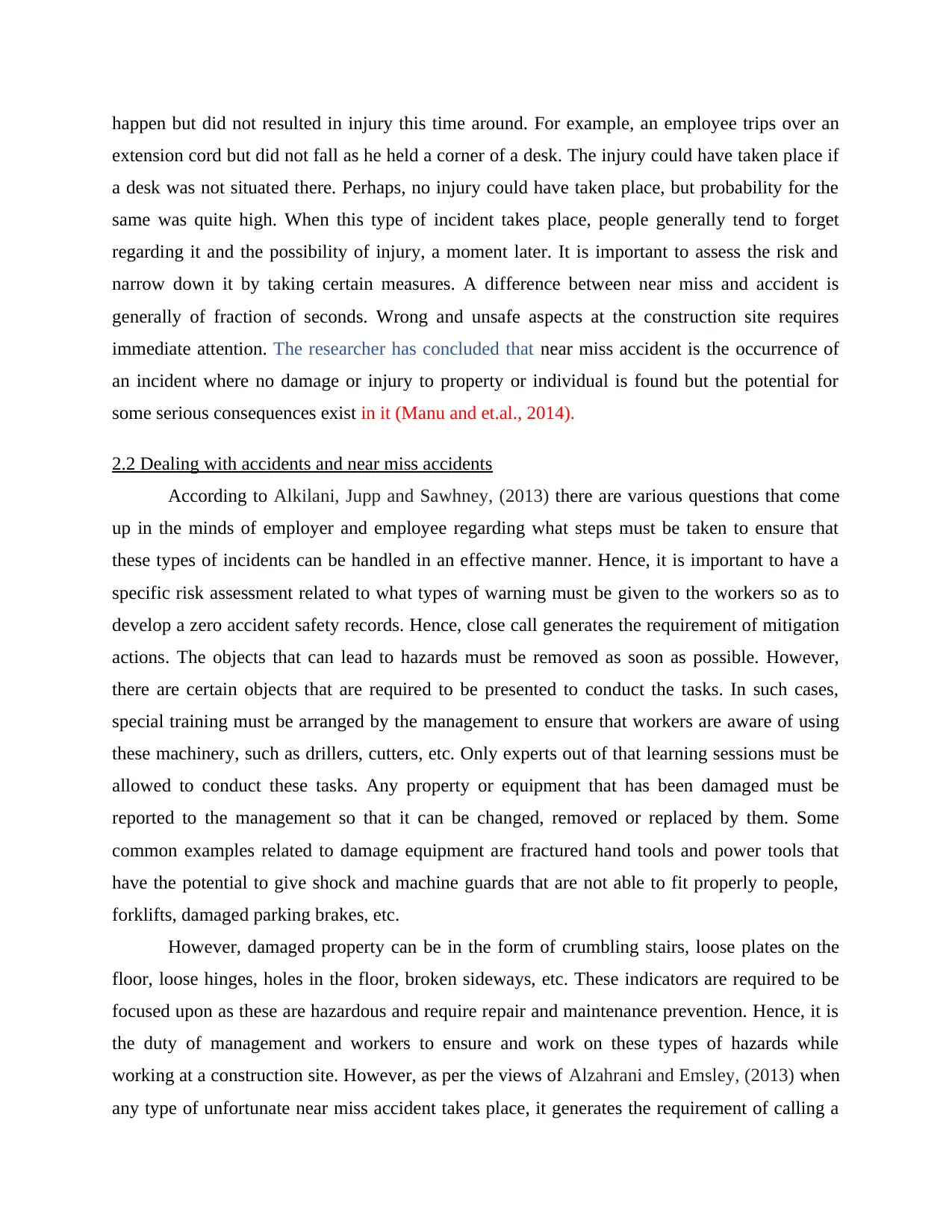
happen but did not resulted in injury this time around. For example, an employee trips over an
extension cord but did not fall as he held a corner of a desk. The injury could have taken place if
a desk was not situated there. Perhaps, no injury could have taken place, but probability for the
same was quite high. When this type of incident takes place, people generally tend to forget
regarding it and the possibility of injury, a moment later. It is important to assess the risk and
narrow down it by taking certain measures. A difference between near miss and accident is
generally of fraction of seconds. Wrong and unsafe aspects at the construction site requires
immediate attention. The researcher has concluded that near miss accident is the occurrence of
an incident where no damage or injury to property or individual is found but the potential for
some serious consequences exist in it (Manu and et.al., 2014).
2.2 Dealing with accidents and near miss accidents
According to Alkilani, Jupp and Sawhney, (2013) there are various questions that come
up in the minds of employer and employee regarding what steps must be taken to ensure that
these types of incidents can be handled in an effective manner. Hence, it is important to have a
specific risk assessment related to what types of warning must be given to the workers so as to
develop a zero accident safety records. Hence, close call generates the requirement of mitigation
actions. The objects that can lead to hazards must be removed as soon as possible. However,
there are certain objects that are required to be presented to conduct the tasks. In such cases,
special training must be arranged by the management to ensure that workers are aware of using
these machinery, such as drillers, cutters, etc. Only experts out of that learning sessions must be
allowed to conduct these tasks. Any property or equipment that has been damaged must be
reported to the management so that it can be changed, removed or replaced by them. Some
common examples related to damage equipment are fractured hand tools and power tools that
have the potential to give shock and machine guards that are not able to fit properly to people,
forklifts, damaged parking brakes, etc.
However, damaged property can be in the form of crumbling stairs, loose plates on the
floor, loose hinges, holes in the floor, broken sideways, etc. These indicators are required to be
focused upon as these are hazardous and require repair and maintenance prevention. Hence, it is
the duty of management and workers to ensure and work on these types of hazards while
working at a construction site. However, as per the views of Alzahrani and Emsley, (2013) when
any type of unfortunate near miss accident takes place, it generates the requirement of calling a
extension cord but did not fall as he held a corner of a desk. The injury could have taken place if
a desk was not situated there. Perhaps, no injury could have taken place, but probability for the
same was quite high. When this type of incident takes place, people generally tend to forget
regarding it and the possibility of injury, a moment later. It is important to assess the risk and
narrow down it by taking certain measures. A difference between near miss and accident is
generally of fraction of seconds. Wrong and unsafe aspects at the construction site requires
immediate attention. The researcher has concluded that near miss accident is the occurrence of
an incident where no damage or injury to property or individual is found but the potential for
some serious consequences exist in it (Manu and et.al., 2014).
2.2 Dealing with accidents and near miss accidents
According to Alkilani, Jupp and Sawhney, (2013) there are various questions that come
up in the minds of employer and employee regarding what steps must be taken to ensure that
these types of incidents can be handled in an effective manner. Hence, it is important to have a
specific risk assessment related to what types of warning must be given to the workers so as to
develop a zero accident safety records. Hence, close call generates the requirement of mitigation
actions. The objects that can lead to hazards must be removed as soon as possible. However,
there are certain objects that are required to be presented to conduct the tasks. In such cases,
special training must be arranged by the management to ensure that workers are aware of using
these machinery, such as drillers, cutters, etc. Only experts out of that learning sessions must be
allowed to conduct these tasks. Any property or equipment that has been damaged must be
reported to the management so that it can be changed, removed or replaced by them. Some
common examples related to damage equipment are fractured hand tools and power tools that
have the potential to give shock and machine guards that are not able to fit properly to people,
forklifts, damaged parking brakes, etc.
However, damaged property can be in the form of crumbling stairs, loose plates on the
floor, loose hinges, holes in the floor, broken sideways, etc. These indicators are required to be
focused upon as these are hazardous and require repair and maintenance prevention. Hence, it is
the duty of management and workers to ensure and work on these types of hazards while
working at a construction site. However, as per the views of Alzahrani and Emsley, (2013) when
any type of unfortunate near miss accident takes place, it generates the requirement of calling a
Paraphrase This Document
Need a fresh take? Get an instant paraphrase of this document with our AI Paraphraser
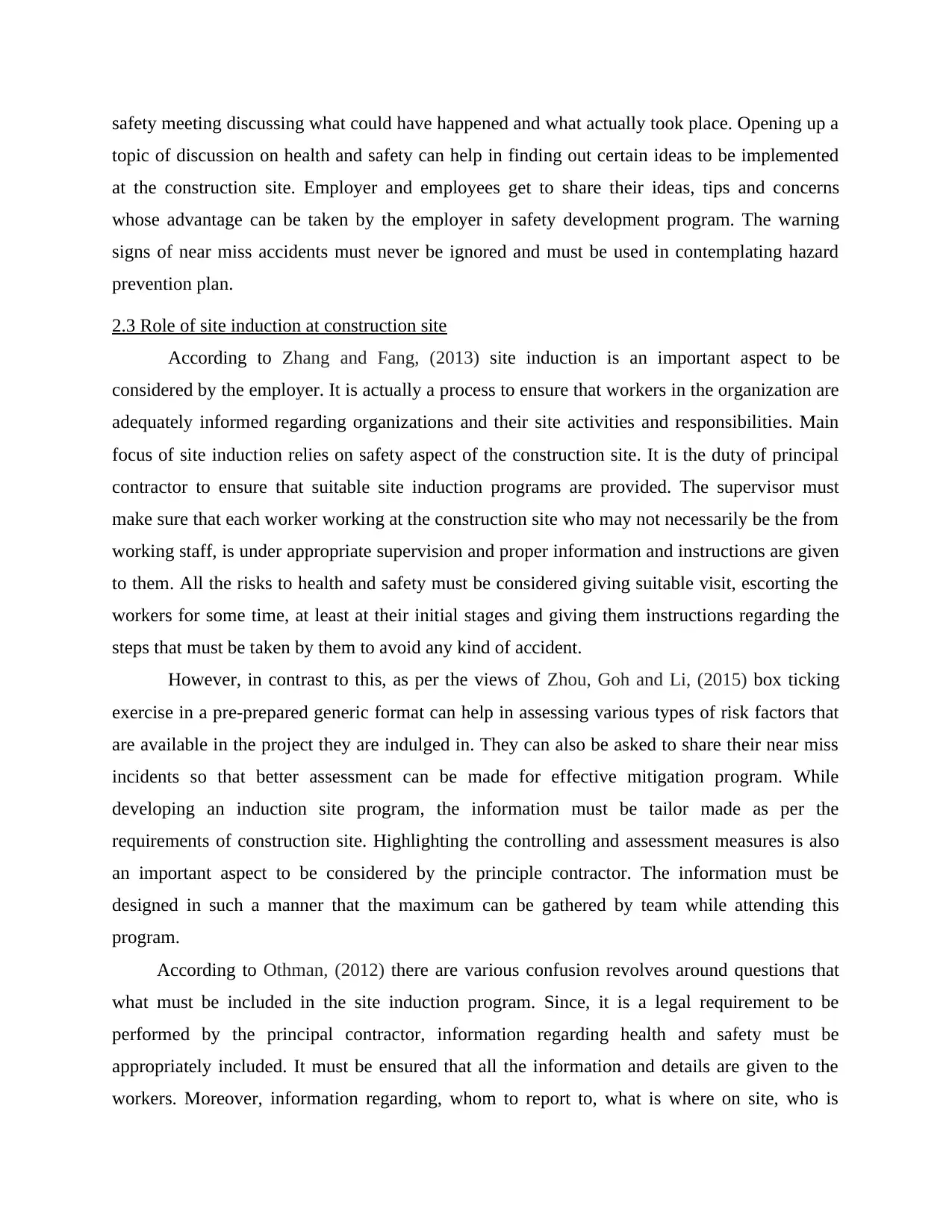
safety meeting discussing what could have happened and what actually took place. Opening up a
topic of discussion on health and safety can help in finding out certain ideas to be implemented
at the construction site. Employer and employees get to share their ideas, tips and concerns
whose advantage can be taken by the employer in safety development program. The warning
signs of near miss accidents must never be ignored and must be used in contemplating hazard
prevention plan.
2.3 Role of site induction at construction site
According to Zhang and Fang, (2013) site induction is an important aspect to be
considered by the employer. It is actually a process to ensure that workers in the organization are
adequately informed regarding organizations and their site activities and responsibilities. Main
focus of site induction relies on safety aspect of the construction site. It is the duty of principal
contractor to ensure that suitable site induction programs are provided. The supervisor must
make sure that each worker working at the construction site who may not necessarily be the from
working staff, is under appropriate supervision and proper information and instructions are given
to them. All the risks to health and safety must be considered giving suitable visit, escorting the
workers for some time, at least at their initial stages and giving them instructions regarding the
steps that must be taken by them to avoid any kind of accident.
However, in contrast to this, as per the views of Zhou, Goh and Li, (2015) box ticking
exercise in a pre-prepared generic format can help in assessing various types of risk factors that
are available in the project they are indulged in. They can also be asked to share their near miss
incidents so that better assessment can be made for effective mitigation program. While
developing an induction site program, the information must be tailor made as per the
requirements of construction site. Highlighting the controlling and assessment measures is also
an important aspect to be considered by the principle contractor. The information must be
designed in such a manner that the maximum can be gathered by team while attending this
program.
According to Othman, (2012) there are various confusion revolves around questions that
what must be included in the site induction program. Since, it is a legal requirement to be
performed by the principal contractor, information regarding health and safety must be
appropriately included. It must be ensured that all the information and details are given to the
workers. Moreover, information regarding, whom to report to, what is where on site, who is
topic of discussion on health and safety can help in finding out certain ideas to be implemented
at the construction site. Employer and employees get to share their ideas, tips and concerns
whose advantage can be taken by the employer in safety development program. The warning
signs of near miss accidents must never be ignored and must be used in contemplating hazard
prevention plan.
2.3 Role of site induction at construction site
According to Zhang and Fang, (2013) site induction is an important aspect to be
considered by the employer. It is actually a process to ensure that workers in the organization are
adequately informed regarding organizations and their site activities and responsibilities. Main
focus of site induction relies on safety aspect of the construction site. It is the duty of principal
contractor to ensure that suitable site induction programs are provided. The supervisor must
make sure that each worker working at the construction site who may not necessarily be the from
working staff, is under appropriate supervision and proper information and instructions are given
to them. All the risks to health and safety must be considered giving suitable visit, escorting the
workers for some time, at least at their initial stages and giving them instructions regarding the
steps that must be taken by them to avoid any kind of accident.
However, in contrast to this, as per the views of Zhou, Goh and Li, (2015) box ticking
exercise in a pre-prepared generic format can help in assessing various types of risk factors that
are available in the project they are indulged in. They can also be asked to share their near miss
incidents so that better assessment can be made for effective mitigation program. While
developing an induction site program, the information must be tailor made as per the
requirements of construction site. Highlighting the controlling and assessment measures is also
an important aspect to be considered by the principle contractor. The information must be
designed in such a manner that the maximum can be gathered by team while attending this
program.
According to Othman, (2012) there are various confusion revolves around questions that
what must be included in the site induction program. Since, it is a legal requirement to be
performed by the principal contractor, information regarding health and safety must be
appropriately included. It must be ensured that all the information and details are given to the
workers. Moreover, information regarding, whom to report to, what is where on site, who is
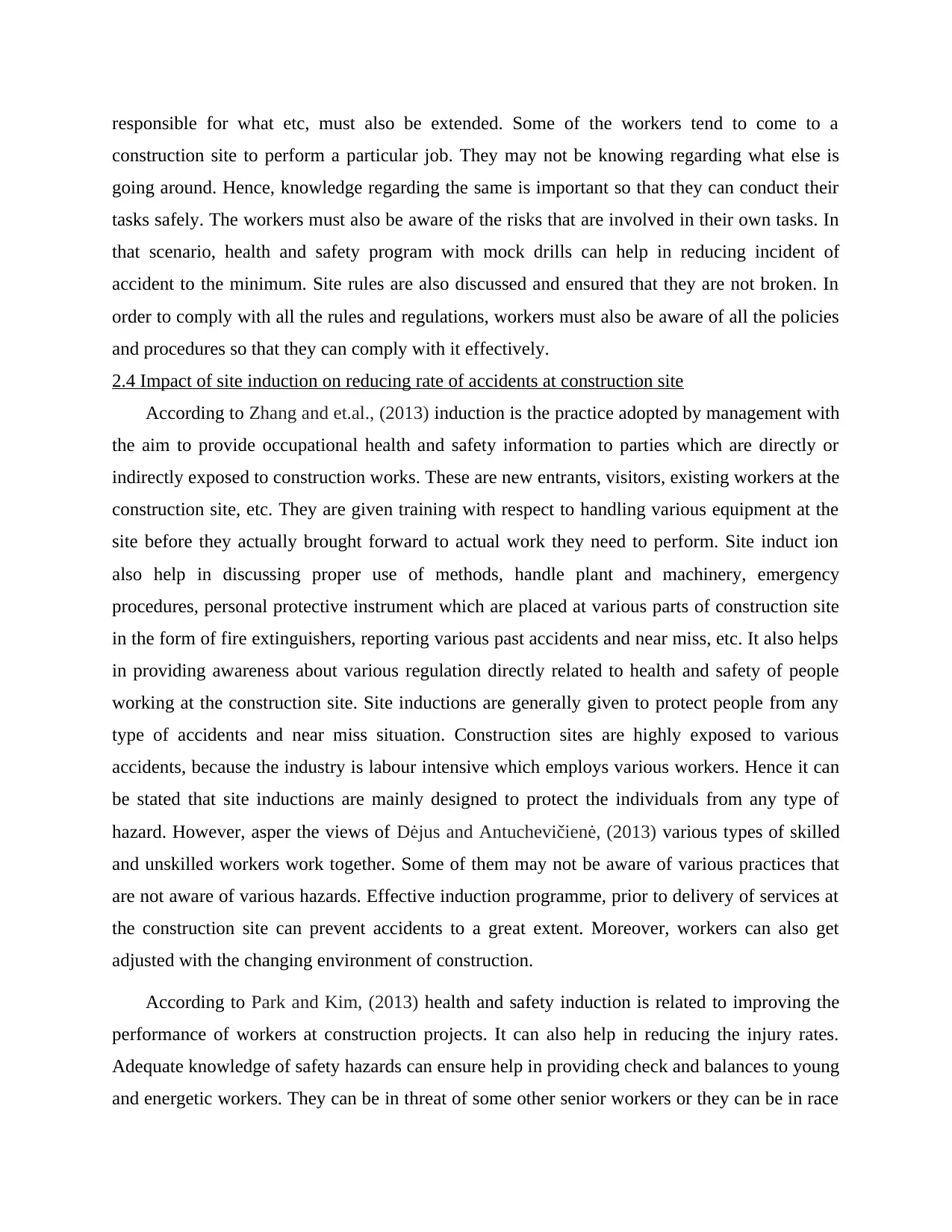
responsible for what etc, must also be extended. Some of the workers tend to come to a
construction site to perform a particular job. They may not be knowing regarding what else is
going around. Hence, knowledge regarding the same is important so that they can conduct their
tasks safely. The workers must also be aware of the risks that are involved in their own tasks. In
that scenario, health and safety program with mock drills can help in reducing incident of
accident to the minimum. Site rules are also discussed and ensured that they are not broken. In
order to comply with all the rules and regulations, workers must also be aware of all the policies
and procedures so that they can comply with it effectively.
2.4 Impact of site induction on reducing rate of accidents at construction site
According to Zhang and et.al., (2013) induction is the practice adopted by management with
the aim to provide occupational health and safety information to parties which are directly or
indirectly exposed to construction works. These are new entrants, visitors, existing workers at the
construction site, etc. They are given training with respect to handling various equipment at the
site before they actually brought forward to actual work they need to perform. Site induct ion
also help in discussing proper use of methods, handle plant and machinery, emergency
procedures, personal protective instrument which are placed at various parts of construction site
in the form of fire extinguishers, reporting various past accidents and near miss, etc. It also helps
in providing awareness about various regulation directly related to health and safety of people
working at the construction site. Site inductions are generally given to protect people from any
type of accidents and near miss situation. Construction sites are highly exposed to various
accidents, because the industry is labour intensive which employs various workers. Hence it can
be stated that site inductions are mainly designed to protect the individuals from any type of
hazard. However, asper the views of Dėjus and Antuchevičienė, (2013) various types of skilled
and unskilled workers work together. Some of them may not be aware of various practices that
are not aware of various hazards. Effective induction programme, prior to delivery of services at
the construction site can prevent accidents to a great extent. Moreover, workers can also get
adjusted with the changing environment of construction.
According to Park and Kim, (2013) health and safety induction is related to improving the
performance of workers at construction projects. It can also help in reducing the injury rates.
Adequate knowledge of safety hazards can ensure help in providing check and balances to young
and energetic workers. They can be in threat of some other senior workers or they can be in race
construction site to perform a particular job. They may not be knowing regarding what else is
going around. Hence, knowledge regarding the same is important so that they can conduct their
tasks safely. The workers must also be aware of the risks that are involved in their own tasks. In
that scenario, health and safety program with mock drills can help in reducing incident of
accident to the minimum. Site rules are also discussed and ensured that they are not broken. In
order to comply with all the rules and regulations, workers must also be aware of all the policies
and procedures so that they can comply with it effectively.
2.4 Impact of site induction on reducing rate of accidents at construction site
According to Zhang and et.al., (2013) induction is the practice adopted by management with
the aim to provide occupational health and safety information to parties which are directly or
indirectly exposed to construction works. These are new entrants, visitors, existing workers at the
construction site, etc. They are given training with respect to handling various equipment at the
site before they actually brought forward to actual work they need to perform. Site induct ion
also help in discussing proper use of methods, handle plant and machinery, emergency
procedures, personal protective instrument which are placed at various parts of construction site
in the form of fire extinguishers, reporting various past accidents and near miss, etc. It also helps
in providing awareness about various regulation directly related to health and safety of people
working at the construction site. Site inductions are generally given to protect people from any
type of accidents and near miss situation. Construction sites are highly exposed to various
accidents, because the industry is labour intensive which employs various workers. Hence it can
be stated that site inductions are mainly designed to protect the individuals from any type of
hazard. However, asper the views of Dėjus and Antuchevičienė, (2013) various types of skilled
and unskilled workers work together. Some of them may not be aware of various practices that
are not aware of various hazards. Effective induction programme, prior to delivery of services at
the construction site can prevent accidents to a great extent. Moreover, workers can also get
adjusted with the changing environment of construction.
According to Park and Kim, (2013) health and safety induction is related to improving the
performance of workers at construction projects. It can also help in reducing the injury rates.
Adequate knowledge of safety hazards can ensure help in providing check and balances to young
and energetic workers. They can be in threat of some other senior workers or they can be in race
⊘ This is a preview!⊘
Do you want full access?
Subscribe today to unlock all pages.

Trusted by 1+ million students worldwide
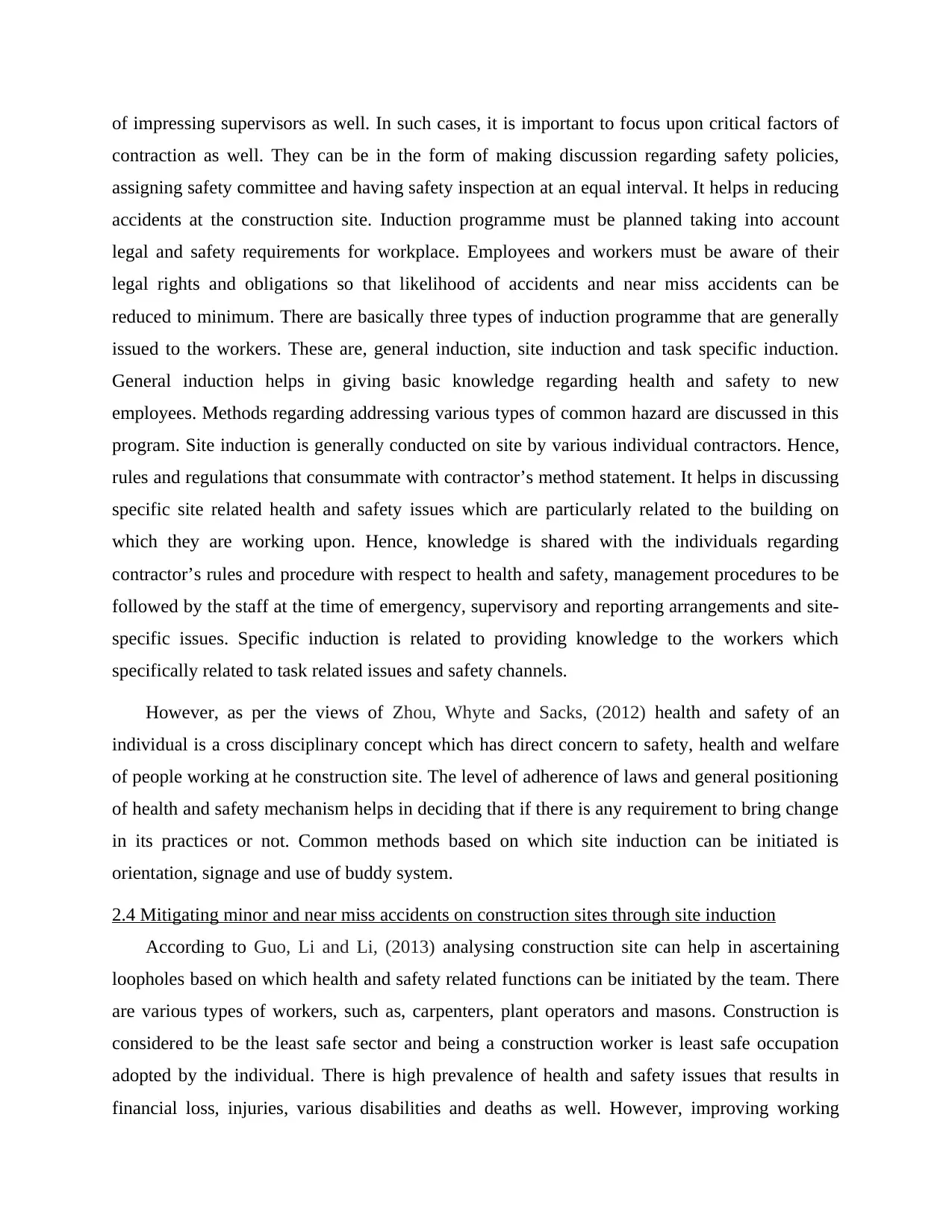
of impressing supervisors as well. In such cases, it is important to focus upon critical factors of
contraction as well. They can be in the form of making discussion regarding safety policies,
assigning safety committee and having safety inspection at an equal interval. It helps in reducing
accidents at the construction site. Induction programme must be planned taking into account
legal and safety requirements for workplace. Employees and workers must be aware of their
legal rights and obligations so that likelihood of accidents and near miss accidents can be
reduced to minimum. There are basically three types of induction programme that are generally
issued to the workers. These are, general induction, site induction and task specific induction.
General induction helps in giving basic knowledge regarding health and safety to new
employees. Methods regarding addressing various types of common hazard are discussed in this
program. Site induction is generally conducted on site by various individual contractors. Hence,
rules and regulations that consummate with contractor’s method statement. It helps in discussing
specific site related health and safety issues which are particularly related to the building on
which they are working upon. Hence, knowledge is shared with the individuals regarding
contractor’s rules and procedure with respect to health and safety, management procedures to be
followed by the staff at the time of emergency, supervisory and reporting arrangements and site-
specific issues. Specific induction is related to providing knowledge to the workers which
specifically related to task related issues and safety channels.
However, as per the views of Zhou, Whyte and Sacks, (2012) health and safety of an
individual is a cross disciplinary concept which has direct concern to safety, health and welfare
of people working at he construction site. The level of adherence of laws and general positioning
of health and safety mechanism helps in deciding that if there is any requirement to bring change
in its practices or not. Common methods based on which site induction can be initiated is
orientation, signage and use of buddy system.
2.4 Mitigating minor and near miss accidents on construction sites through site induction
According to Guo, Li and Li, (2013) analysing construction site can help in ascertaining
loopholes based on which health and safety related functions can be initiated by the team. There
are various types of workers, such as, carpenters, plant operators and masons. Construction is
considered to be the least safe sector and being a construction worker is least safe occupation
adopted by the individual. There is high prevalence of health and safety issues that results in
financial loss, injuries, various disabilities and deaths as well. However, improving working
contraction as well. They can be in the form of making discussion regarding safety policies,
assigning safety committee and having safety inspection at an equal interval. It helps in reducing
accidents at the construction site. Induction programme must be planned taking into account
legal and safety requirements for workplace. Employees and workers must be aware of their
legal rights and obligations so that likelihood of accidents and near miss accidents can be
reduced to minimum. There are basically three types of induction programme that are generally
issued to the workers. These are, general induction, site induction and task specific induction.
General induction helps in giving basic knowledge regarding health and safety to new
employees. Methods regarding addressing various types of common hazard are discussed in this
program. Site induction is generally conducted on site by various individual contractors. Hence,
rules and regulations that consummate with contractor’s method statement. It helps in discussing
specific site related health and safety issues which are particularly related to the building on
which they are working upon. Hence, knowledge is shared with the individuals regarding
contractor’s rules and procedure with respect to health and safety, management procedures to be
followed by the staff at the time of emergency, supervisory and reporting arrangements and site-
specific issues. Specific induction is related to providing knowledge to the workers which
specifically related to task related issues and safety channels.
However, as per the views of Zhou, Whyte and Sacks, (2012) health and safety of an
individual is a cross disciplinary concept which has direct concern to safety, health and welfare
of people working at he construction site. The level of adherence of laws and general positioning
of health and safety mechanism helps in deciding that if there is any requirement to bring change
in its practices or not. Common methods based on which site induction can be initiated is
orientation, signage and use of buddy system.
2.4 Mitigating minor and near miss accidents on construction sites through site induction
According to Guo, Li and Li, (2013) analysing construction site can help in ascertaining
loopholes based on which health and safety related functions can be initiated by the team. There
are various types of workers, such as, carpenters, plant operators and masons. Construction is
considered to be the least safe sector and being a construction worker is least safe occupation
adopted by the individual. There is high prevalence of health and safety issues that results in
financial loss, injuries, various disabilities and deaths as well. However, improving working
Paraphrase This Document
Need a fresh take? Get an instant paraphrase of this document with our AI Paraphraser
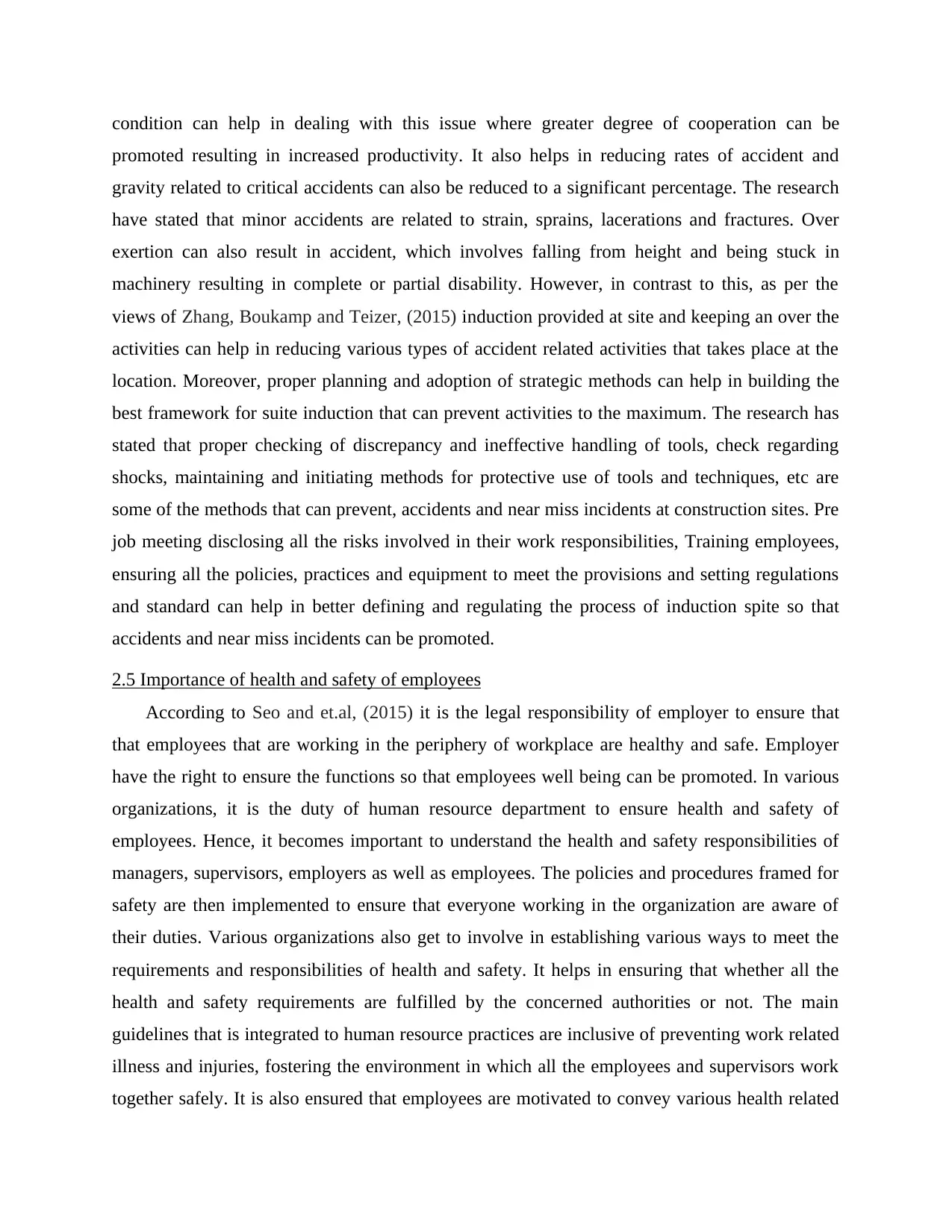
condition can help in dealing with this issue where greater degree of cooperation can be
promoted resulting in increased productivity. It also helps in reducing rates of accident and
gravity related to critical accidents can also be reduced to a significant percentage. The research
have stated that minor accidents are related to strain, sprains, lacerations and fractures. Over
exertion can also result in accident, which involves falling from height and being stuck in
machinery resulting in complete or partial disability. However, in contrast to this, as per the
views of Zhang, Boukamp and Teizer, (2015) induction provided at site and keeping an over the
activities can help in reducing various types of accident related activities that takes place at the
location. Moreover, proper planning and adoption of strategic methods can help in building the
best framework for suite induction that can prevent activities to the maximum. The research has
stated that proper checking of discrepancy and ineffective handling of tools, check regarding
shocks, maintaining and initiating methods for protective use of tools and techniques, etc are
some of the methods that can prevent, accidents and near miss incidents at construction sites. Pre
job meeting disclosing all the risks involved in their work responsibilities, Training employees,
ensuring all the policies, practices and equipment to meet the provisions and setting regulations
and standard can help in better defining and regulating the process of induction spite so that
accidents and near miss incidents can be promoted.
2.5 Importance of health and safety of employees
According to Seo and et.al, (2015) it is the legal responsibility of employer to ensure that
that employees that are working in the periphery of workplace are healthy and safe. Employer
have the right to ensure the functions so that employees well being can be promoted. In various
organizations, it is the duty of human resource department to ensure health and safety of
employees. Hence, it becomes important to understand the health and safety responsibilities of
managers, supervisors, employers as well as employees. The policies and procedures framed for
safety are then implemented to ensure that everyone working in the organization are aware of
their duties. Various organizations also get to involve in establishing various ways to meet the
requirements and responsibilities of health and safety. It helps in ensuring that whether all the
health and safety requirements are fulfilled by the concerned authorities or not. The main
guidelines that is integrated to human resource practices are inclusive of preventing work related
illness and injuries, fostering the environment in which all the employees and supervisors work
together safely. It is also ensured that employees are motivated to convey various health related
promoted resulting in increased productivity. It also helps in reducing rates of accident and
gravity related to critical accidents can also be reduced to a significant percentage. The research
have stated that minor accidents are related to strain, sprains, lacerations and fractures. Over
exertion can also result in accident, which involves falling from height and being stuck in
machinery resulting in complete or partial disability. However, in contrast to this, as per the
views of Zhang, Boukamp and Teizer, (2015) induction provided at site and keeping an over the
activities can help in reducing various types of accident related activities that takes place at the
location. Moreover, proper planning and adoption of strategic methods can help in building the
best framework for suite induction that can prevent activities to the maximum. The research has
stated that proper checking of discrepancy and ineffective handling of tools, check regarding
shocks, maintaining and initiating methods for protective use of tools and techniques, etc are
some of the methods that can prevent, accidents and near miss incidents at construction sites. Pre
job meeting disclosing all the risks involved in their work responsibilities, Training employees,
ensuring all the policies, practices and equipment to meet the provisions and setting regulations
and standard can help in better defining and regulating the process of induction spite so that
accidents and near miss incidents can be promoted.
2.5 Importance of health and safety of employees
According to Seo and et.al, (2015) it is the legal responsibility of employer to ensure that
that employees that are working in the periphery of workplace are healthy and safe. Employer
have the right to ensure the functions so that employees well being can be promoted. In various
organizations, it is the duty of human resource department to ensure health and safety of
employees. Hence, it becomes important to understand the health and safety responsibilities of
managers, supervisors, employers as well as employees. The policies and procedures framed for
safety are then implemented to ensure that everyone working in the organization are aware of
their duties. Various organizations also get to involve in establishing various ways to meet the
requirements and responsibilities of health and safety. It helps in ensuring that whether all the
health and safety requirements are fulfilled by the concerned authorities or not. The main
guidelines that is integrated to human resource practices are inclusive of preventing work related
illness and injuries, fostering the environment in which all the employees and supervisors work
together safely. It is also ensured that employees are motivated to convey various health related
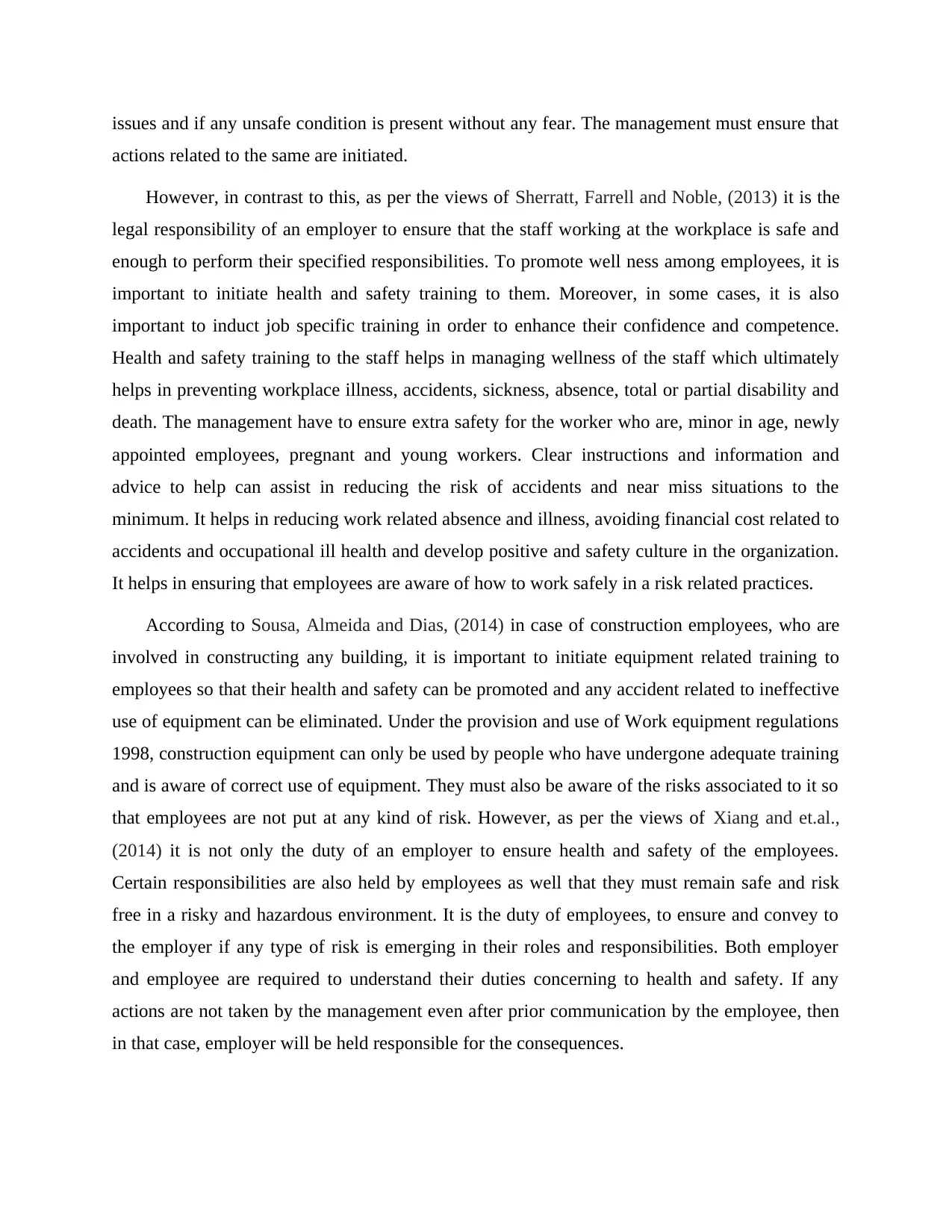
issues and if any unsafe condition is present without any fear. The management must ensure that
actions related to the same are initiated.
However, in contrast to this, as per the views of Sherratt, Farrell and Noble, (2013) it is the
legal responsibility of an employer to ensure that the staff working at the workplace is safe and
enough to perform their specified responsibilities. To promote well ness among employees, it is
important to initiate health and safety training to them. Moreover, in some cases, it is also
important to induct job specific training in order to enhance their confidence and competence.
Health and safety training to the staff helps in managing wellness of the staff which ultimately
helps in preventing workplace illness, accidents, sickness, absence, total or partial disability and
death. The management have to ensure extra safety for the worker who are, minor in age, newly
appointed employees, pregnant and young workers. Clear instructions and information and
advice to help can assist in reducing the risk of accidents and near miss situations to the
minimum. It helps in reducing work related absence and illness, avoiding financial cost related to
accidents and occupational ill health and develop positive and safety culture in the organization.
It helps in ensuring that employees are aware of how to work safely in a risk related practices.
According to Sousa, Almeida and Dias, (2014) in case of construction employees, who are
involved in constructing any building, it is important to initiate equipment related training to
employees so that their health and safety can be promoted and any accident related to ineffective
use of equipment can be eliminated. Under the provision and use of Work equipment regulations
1998, construction equipment can only be used by people who have undergone adequate training
and is aware of correct use of equipment. They must also be aware of the risks associated to it so
that employees are not put at any kind of risk. However, as per the views of Xiang and et.al.,
(2014) it is not only the duty of an employer to ensure health and safety of the employees.
Certain responsibilities are also held by employees as well that they must remain safe and risk
free in a risky and hazardous environment. It is the duty of employees, to ensure and convey to
the employer if any type of risk is emerging in their roles and responsibilities. Both employer
and employee are required to understand their duties concerning to health and safety. If any
actions are not taken by the management even after prior communication by the employee, then
in that case, employer will be held responsible for the consequences.
actions related to the same are initiated.
However, in contrast to this, as per the views of Sherratt, Farrell and Noble, (2013) it is the
legal responsibility of an employer to ensure that the staff working at the workplace is safe and
enough to perform their specified responsibilities. To promote well ness among employees, it is
important to initiate health and safety training to them. Moreover, in some cases, it is also
important to induct job specific training in order to enhance their confidence and competence.
Health and safety training to the staff helps in managing wellness of the staff which ultimately
helps in preventing workplace illness, accidents, sickness, absence, total or partial disability and
death. The management have to ensure extra safety for the worker who are, minor in age, newly
appointed employees, pregnant and young workers. Clear instructions and information and
advice to help can assist in reducing the risk of accidents and near miss situations to the
minimum. It helps in reducing work related absence and illness, avoiding financial cost related to
accidents and occupational ill health and develop positive and safety culture in the organization.
It helps in ensuring that employees are aware of how to work safely in a risk related practices.
According to Sousa, Almeida and Dias, (2014) in case of construction employees, who are
involved in constructing any building, it is important to initiate equipment related training to
employees so that their health and safety can be promoted and any accident related to ineffective
use of equipment can be eliminated. Under the provision and use of Work equipment regulations
1998, construction equipment can only be used by people who have undergone adequate training
and is aware of correct use of equipment. They must also be aware of the risks associated to it so
that employees are not put at any kind of risk. However, as per the views of Xiang and et.al.,
(2014) it is not only the duty of an employer to ensure health and safety of the employees.
Certain responsibilities are also held by employees as well that they must remain safe and risk
free in a risky and hazardous environment. It is the duty of employees, to ensure and convey to
the employer if any type of risk is emerging in their roles and responsibilities. Both employer
and employee are required to understand their duties concerning to health and safety. If any
actions are not taken by the management even after prior communication by the employee, then
in that case, employer will be held responsible for the consequences.
⊘ This is a preview!⊘
Do you want full access?
Subscribe today to unlock all pages.

Trusted by 1+ million students worldwide
1 out of 16
Related Documents
Your All-in-One AI-Powered Toolkit for Academic Success.
+13062052269
info@desklib.com
Available 24*7 on WhatsApp / Email
![[object Object]](/_next/static/media/star-bottom.7253800d.svg)
Unlock your academic potential
Copyright © 2020–2025 A2Z Services. All Rights Reserved. Developed and managed by ZUCOL.





